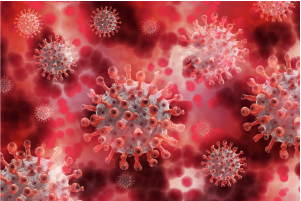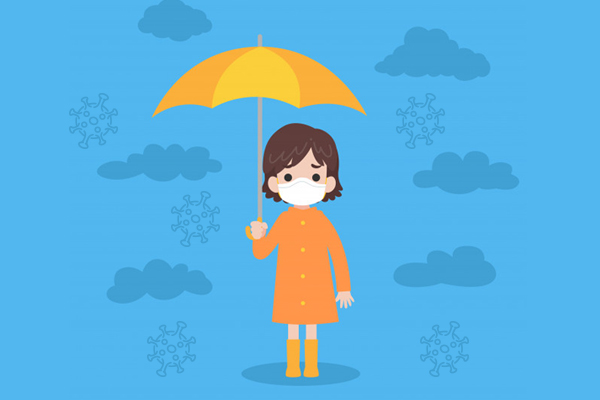World Asthma Day 2024: Know About Causes, Preventions & Treatments
Updated On Apr 30, 2024
Every year since 1998, the first Tuesday in May has been designated as World Asthma Day - a day to raise awareness of asthma. The inaugural World Asthma Day conference took place in Barcelona, Spain. Lawmakers and pharmaceutical firms are encouraged to raise awareness of this widespread but preventable illness. To raise awareness and ensure that environmentally friendly inhalation medicines and other equipment are available in every country, efforts are being undertaken to leave no one behind.
According to GINA, over 260 million people worldwide suffer from asthma, which is the most general chronic non-communicable disease and results in over 4,50,000 deaths annually. These deaths could have been avoided if there was enough knowledge about the disease and access to proper resources. Low-income nations are the most affected due to a lack of, awareness, healthcare facilities, and medications, accounting for over 90% of all asthma-related deaths globally.
Global Initiative for Asthma (GINA) has taken the initiative to ensure people are aware of the disease and take proper precautions and medications. The theme for World Asthma Day 2024 chosen by GINA is “ Asthma Education Empowers”. They want to make sure people have access to knowledge about the illness and have proper medications available when needed. [1]

Asthma Symptoms
The symptoms of asthma include wheezing, coughing, shortness of breath, tightness of chest, etc. However, it may differ with age. These symptoms may be brought on by other illnesses. However, there is a common pattern to the symptoms of asthma:
-
They arrive and depart throughout the day.
-
Colds and other viral diseases can cause them to begin or worsen.
-
Exercise, allergies, chilly air, or inhaling too quickly after laughing or crying can all cause asthma.
-
At night and early in the morning the symptoms might get worse.
Young children with asthma may experience distinct symptoms, and as you age, these symptoms may also vary. Childhood is the typical start of asthma because this is the time when the body's natural defences are still growing. Infections with viruses and exposure to hassles like cigarette smoke can increase the child's risk of asthma. A child's risk is further increased if they have an asthmatic parent, particularly a mother. Asthma affects more boys than girls in childhood. Compared to adults, children may experience various asthma symptoms:
-
Youngsters may wake up frequently or cough while they sleep.
-
They might stay away from severe activities to avoid getting sick.
-
They might not be able to play, run, or laugh as much as other kids because of this.
-
They can grow tired easily. They might appear more agitated and ask to be carried when on outings.
If asthma worsens, the symptoms can be prolonged and drastic. If you notice any of the following symptoms, your asthma may worsen:
-
You experience symptoms occurring more frequently than normal.
-
You're using your pain reliever more frequently than usual.
-
Coughing or other asthmatic symptoms lead you to wake up during the night.
-
When it's even more difficult for you to do daily tasks like exercise.
Causes of Asthma
It is unknown what exactly triggers asthma attacks and it may vary from person to person. But asthma can also happen when the body's defences against illness and bacteria are overreacted to something foreign in the lungs.
Asthma typically develops in childhood, when the body's defence mechanisms are still developing. On the other hand, adult-onset asthma refers to those who develop asthma symptoms later in life. Several variables can influence the development of your lungs or your immune system.
-
Items from your surroundings (also known as allergens) that harmed you as a newborn or early kid, such as cigarette smoke.
-
Certain bacteria have respiratory-related viral illnesses.
-
Family history, including the presence of an asthmatic parent (particularly your mother).
Asthma risk factors may also include the following:
Allergies: An allergic reaction is typically what causes asthma. Allergies to food, pollen, or other substances are common in people with asthma.
Obesity: Being overweight might worsen asthma symptoms or increase your chance of getting asthma.
Sex: Childhood asthma affects boys more often than girls. Adult women are more likely than males to have asthma.
Workplace hazards: Breathing in industrial dust or chemicals increases the chance of developing asthma.
Climate change: Exposure to allergens and the onset of asthma are influenced by air pollution and shifting weather patterns.
How Asthma Affects the Lungs?
The body's defence mechanisms often help in the battle against infections. However, it might also react to inhaled allergens like mould or pollen. In certain individuals, a significant reaction from the immune system results in inflammation. Inhaling normally harmless substances can also cause the airways to constrict excessively and become hypersensitive.
The result is swelling, narrowing of the airways, and increased mucus production. Moreover, the muscles around the airways may tense. Breathing may become more difficult as a result. The walls of the airways may thicken with time.
Asthma Diagnosis
Get in touch with your doctors if you or your children exhibit any symptoms of asthma. To ensure that you receive proper care, be specific about all the issues you've had while leaving nothing out.
The following tests can help diagnose asthma:-
Lung Function Test (LFT)
-
Spirometry measures your exhalation rate and volume of air. The breathing effort required for this test causes some people to feel dizzy or exhausted.
-
Tests known as peak expiratory flow (PEF) evaluate how quickly you can expel air while exerting your greatest effort. The test can be performed using a tiny handheld instrument or during spirometry.
-
Testing your ability to breathe after breathing a fast-acting bronchodilator, a medication that helps open your airways by relaxing the surrounding muscles, is known as bronchodilator responsiveness. Your spirometry or PEF readings before and after the medication are compared in this test.
Challenge Tests
Challenge tests measure the sensitivity of your airways. They are also known as bronchial provocation tests. The speed at which you can exhale before and after a challenge agent is compared in these tests. Challenge agents include drugs or activities that can cause your airway muscles to tense up if they get irritated from being too sensitive. Examples of these include:
-
Medications Inhaled, such as histamine, mannitol, or methacholine.
-
Allergens or irritants that, in those without asthma, do not trigger a reaction.
-
Exercise dries and cools the respiratory tract.
-
Hyperventilation, or rapid, shallow breathing.
For young children, the majority of asthma diagnostic tests are not very effective. As a result, diagnosing asthma in youngsters may be challenging.
Determining if a child under 6 has asthma or another breathing disorder might be challenging. Spirometry testing, the most widely used asthma diagnostic tool, is frequently unachievable for young children. Rather, the medical professional treating your child will want to hear about their medical background and current symptoms. You can help your doctor confirm the symptoms if you believe your child is wheezing by using a smartphone to capture their breathing. They could advise giving asthma medications to your child for a few months to observe how well they work.
Asthma Treatments
Age, the severity of your symptoms, and how your body reacts to medication are all major factors in asthma treatment. Even with increased medication, asthma can be difficult to manage for many people.
Some take medication daily to manage and avoid symptoms. Additionally, you can pack medications while going out to utilise them in the event of an asthma attack, such as an inhaler. Until your asthma symptoms are under control, your healthcare professional may modify your course of therapy.
Quick Relief Medications
Medications are known as relievers or quick-relief aids in preventing or lessening asthma attack symptoms. If your asthma is mild or flares up mainly during physical activity, these might be all the medications you need.
Most likely, your doctor would recommend that you always have a quick-relief inhaler. Make sure you understand how to use your asthma inhaler appropriately for the medication to be effective.
The following are some typical relievers:-
-
Short-acting beta2-agonists (SABAs) that are inhaled expand the airways to allow for the passage of air. Tremors and an accelerated heartbeat are possible side effects.
-
Swelling in your airways is reduced with oral corticosteroids.
-
Fast-acting anticholinergics aid in rapidly opening the airways. Although this medication might not be as effective as SABAs, it is still a viable choice for those who might have SABA adverse effects.
Long-Term Control Medications
The following controller medications may be prescribed by your doctor to assist manage symptoms and stop asthma attacks:
-
Corticosteroids, or steroid hormone medications, lessen the body's inflammation. They can be inhaled or taken as a pill. Compared to the inhaled form, the tablet form may cause more severe side effects. High doses over time may increase your risk of osteoporosis or cataracts. A thrush infection or a hoarse voice are common side effects of inhaled corticosteroids.
-
Benralizumab is one biological medication that may help with hard-to-control asthma. These medications are injected under the skin or into a vein.
-
Leukotriene modifiers keep your airways open while reducing edema. Your doctor may recommend these tablets in addition to or instead of steroid medication.
-
Asthma triggers and allergens can cause swelling in your airways, which can be avoided by using inhaled mast cell stabilisers like cromolyn.
-
To keep your airways from narrowing, an inhaler containing long-acting bronchodilators, such as long-acting muscarinic antagonists (LAMAs) or long-acting beta2 agonists (LABAs), may be added.
-
Subcutaneous immunotherapy, often known as allergy shots, reduces the body's reaction to allergens.
Bronchial Thermoplasty
If previous therapies are not helping and you have severe asthma, bronchial thermoplasty might be able to help. To look inside your airways, your healthcare practitioner will put a bronchoscope, a tube with a camera at the end through your mouth during this procedure. After that, your healthcare practitioner will apply heat to the muscles that line your airway walls. This may help them get thinner and keep from narrowing.
Managing Asthma
How to manage asthma at home?
Take these actions to assist in managing your asthma:
Seek out assistance or training groups. Ask your healthcare practitioner about asthma community groups.
Recognize your asthma. Learn about the functions of your medications and how to avoid symptoms by educating yourself. Learn how to recognize asthma attacks early and when to seek medical attention.
Keep an eye on your breathing. Your healthcare practitioner may demonstrate to you how to use a peak flow metre to monitor your asthma as part of your asthma action plan. Maintain a log of your outcomes. To verify that your asthma is under control, you can compare your numbers over time. Even before you have symptoms, a low number can help alert you to an upcoming asthma attack.
When you have an asthma attack, make a note of it and bring the record with you to your next appointment.
Know your asthma triggers
To prevent triggers, stick to the following steps:
-
If you have asthma, keep pets with fur out of your bedrooms and house.
-
Your home should be free of mould and dust.
-
Stay away from the things at work that are making you sick. Even modest allergen concentrations can cause symptoms to flare up if you have occupational asthma.
-
If there are a lot of allergens outside, spend less time there.
-
When the air quality is poor, keep windows closed and steer clear of strenuous outdoor activities.
-
Take precautions to keep your lungs healthy. Consult your doctor about receiving the vaccinations against pneumonia and the flu. To reduce your chance of contracting bacterial and viral infections, wash your hands frequently. Discover the effects of COVID-19 on your lungs.
-
Inform your healthcare practitioner of all the medications you use. Those with difficult-to-treat asthma may experience severe breathing difficulties when using aspirin and other medications.
-
At home, steer clear of air pollution. Maintain good ventilation for heating and cooking appliances indoors.
-
Steer clear of tobacco smoke, especially that from others.
Make Lifestyle Changes
To assist control asthma symptoms, your healthcare professional could suggest the following healthy lifestyle modifications:
-
Pursue a balanced weight. Obesity or being overweight can make it more difficult to control asthma. Consult your provider about available programs. Symptoms may improve with even a modest weight loss.
-
Make heart-healthy eating choices. Consuming a diet richer in fruits and vegetables can cause significant health advantages, including a decreased chance of developing asthma and improved management of symptoms.
-
Engage in regular exercise. You shouldn't avoid exercise even though it can induce asthma attacks in certain individuals. An essential component of a healthy lifestyle is physical activity. Discuss the appropriate amount of physical activity for you with your healthcare professional. Find out what medications can keep you moving.
-
Control your tension. Relaxation and breathing exercises can alleviate discomfort. Consult a mental health specialist if you experience panic attacks, sadness, or anxiety.
-
Prevent secondhand smoke and give up smoking. Asthma treatment is more difficult when one smokes tobacco and breathes in secondhand smoke. The symptoms of asthma may also heighten if you heat tobacco, inhale vapour from electronic cigarettes (e-cigarettes), or are around second-hand vapour. Nicotine, a component of tobacco plants that causes smoking addiction, and flavourings in e-cigarettes can harm your lungs.
-
Make sure you get adequate restful sleep. Having asthma could make it difficult to get a good night's sleep. Establish healthy sleep patterns by keeping your bedroom cold and dark, going to bed and waking up at the same time every day, and following a relaxing nighttime routine.
Asthma In children
Asthma cannot be cured, but it can be managed with certain measures. The doctor who treats your child will teach you how to manage it by avoiding triggers, administering medication, and monitoring symptoms.
Together, you and your healthcare practitioner will create an asthma action plan for your child. This will assist you in recognizing asthma attack triggers and how to handle them. Give the school administration and other caregivers a copy of your child's asthma action plan.
Myths About Asthma
-
Medications for asthma are dangerous, can become addictive, and eventually lose their effectiveness.
-
Individuals who have asthma shouldn't work out, play sports, or go to the gym.
-
Asthma is only a childhood ailment that usually passes.
-
Asthma is easily handled and is not a serious health concern.
-
Asthma is not the cause if you are not wheezing.
Myths are mostly the reason for improper care, treatment and diagnosis of patients. Not getting proper care can cause the disease to become severe.
Conclusion
World Asthma Day is observed to raise awareness of the illness and ensure that everyone receives the recommended care and medicines. Most health insurance plans cover asthma under the categories of critical illness and pre-existing conditions. Customer’s financial burdens are lessened as a result. InsuranceDekho assists in fitting clients with the ideal plan based on their unique medical requirements.[2]
Also Read: Best Health Insurance Plans for Asthma
Top Health Insurance Companies in India Which Covers Asthma
References
[1]https://ginasthma.org/world-asthma-day-may-7-2024/
[2]https://www.insurancedekho.com/health-insurance/articles/health-insurance-plans-for-asthma-patients-660











































































